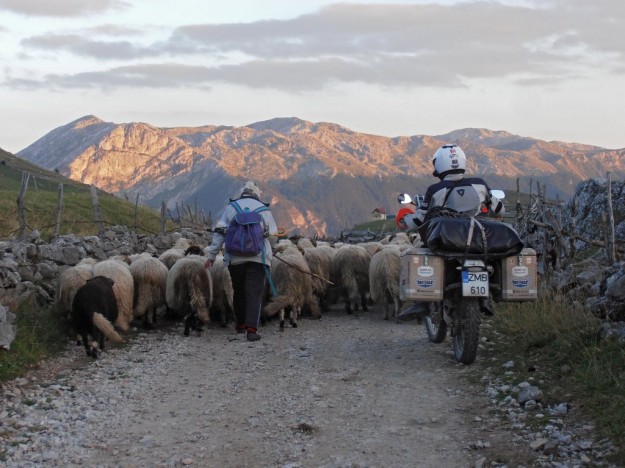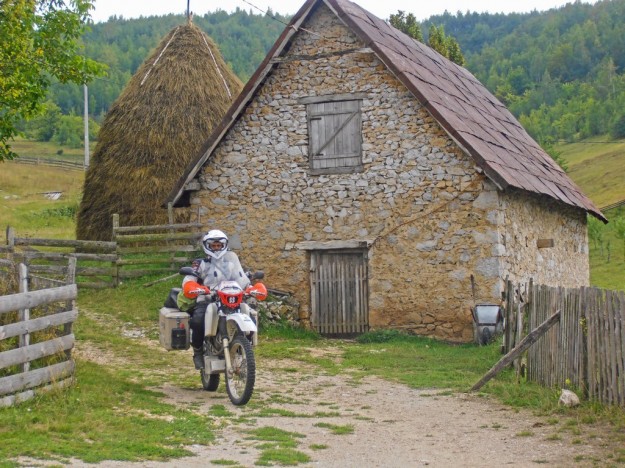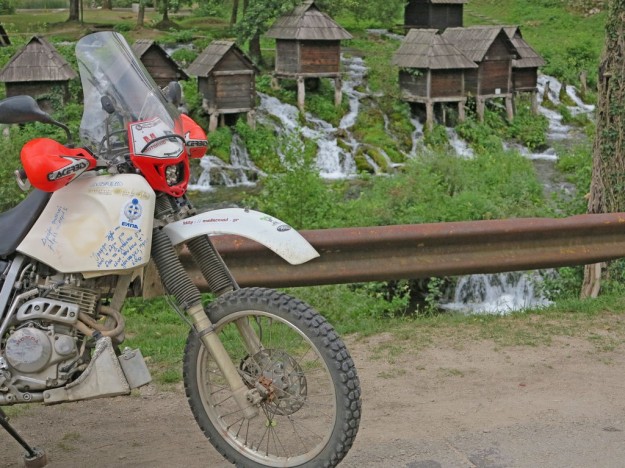Bosnia and HerzegovinaΒοσνία – Ερζεγοβίνη
Entering Bosnia and Herzegovina, we enjoyed a nice dirt ride to Mount Bjelašnica. We visited the village of Umoljani and we wild-camped near the isolated village of Lukomir. Until 2010 this beautiful village was inhabited by just ten people during the winter. Now, no one lives there in the winter. Shepherds just come over during the summer with hundreds of sheeps, just to take advantage of the lush meadows of the area.

Entering the remote Lukomir, we bumped into the shepherds returning to the village with their animals after pasturing.
The next day, we arrived in Sarajevo, this crossroad of different cultures that has suffered so much in the past. The impact of the war during 1992-1995 is more than obvious. You can see graveyards everywhere, while the buildings are full of scars created by shelling. Many of them are covered up and the capital has been modernized. The scars on people’s souls, however, are not that easy to be vanished. Nevertheless, it is impressive in a good way to see Christians together with religious Muslims, walking around the streets of the city. Apparently, nowadays they live together in peace.
It was time to say goodbye to John, as he was taking the road back to Greece. Although, we didn’t know each other that well when we decided to travel together for a while, he was probably the best fellow traveller I could have asked for. He was optimistic all the time and never complained about anything (well, he used to nag a little bit when we were facing crags and steep cliffs, but he enjoyed it in the end!). Even when we couldn’t find a nice place for us to wild-camp, he was always smiling saying: “over here, it’s perfect!”, even though the place might have been full of rocks or just very close to the road. John is almost 60 years old, but this has never prevented him from travelling in such a style.

Sarajevo, crossroad of East and West, combining mosques, churches, old houses of Ottoman architecture and modern sky-crappers…
The reason I write all these is not to over praise John but to prove once more that age is not a barrier for someone to sleep on rocks under the stars every night, to cook on a camping stove and eat just one or two times a day, to ride his motorcycle along rocky cliffs and not to have a clue about where he will end up, what he might run into or where he will sleep. And don’t think that his gear was helpful in any way… He has an old, wrecked AX-1 250 cc, which had trouble with the shock absorber, it had a broken ball-bearing on the rear wheel, broken safety bars and displaced hand guard… Let alone his tent… It was one of those cheap tents that he had to cover with nylon when it was down pouring. The tricky thing, however, in such tents is to prevent the water to enter inside through the tent floor.
And don’t think that he has a great fortune or anything… Thankfully, our financial situation was one more thing we had in common, so, without spending a single night in a hotel, during the three weeks we travelled together, John must have spent around 300 euros in total. All these stand as a proof that it takes no more than will to travel like that and that age is not more than an excuse used by many who see such a trip as a hassle.
It was time for me to replace the engine oil on my motorcycle for the first time during this trip. I went over a gas station to use one of their containers in order to dispose the used oil. Next stop was the mysterious Visoko. There, it is said to be one of the oldest and largest pyramids in the world, the Pyramid of Sun. It was built almost 12,000 years ago with its height being more than 220 m. (722 ft.)! Now you can see just a hill and at first I thought it would be a waste of time to visit it. When I visited the Ravne Tunnel, however, I changed my mind! It was a labyrinth of tunnels of many kilometres, built in the same era as the pyramid complex.
We had a very good tour guide, who was very keen to show us the tunnels from a metaphysic viewpoint. He showed us the rock boulders situated above the conjunction of two subterranean rivers, inside of which, by the use of proper instruments, there were found quartz crystals. At the underground galleries we visited, there was 40 times more than the ordinary amount of negative ions in the atmosphere, which is very beneficial to our health! Global scientists have been performing various calculations in order to reveal all these fascinating properties of the area. Now you can see many volunteers from all over the world, enchanted by the mysterious Visoko, coming over to assist in the excavations and the cleaning of the tunnels.
I headed to the picturesque village of Vranduk, where I made a stroll around the imposing 14th-century castle. Moving on, after paying the old town of Travnik a short visit, I arrived at Jajce. There, I was a guest of Sabina, a Bosnian girl that had hosted my sister and her boyfriend a month ago, while they were around the Balkans hitchhiking. Jajce is a peaceful town, located in a beautiful area full of rivers, waterfalls and lakes. All these, combined with the old citadel, create a fairytale landscape.
From there, I headed south once more, in order not to lose the main attraction of Bosnia and Herzegovina, Mostar! The notorious Suleiman the Magnificent had ordered the building of the famous bridge, which was completed in 1566, and now attracts vast hordes of tourists, as it is considered to be a miracle of engineering.
I visited many interesting places in this region. Kravice waterfalls overflow inside a lake, ideal for taking a cooling dip. The landscape is stunning! It was just like a miniature of the images I’ve seen from the Krka National Park or Plitvice Lakes in Croatia, however not so crowded and without expensive entry tickets.
One more thing that really impressed me was the necropolis of Radimlja! Bosnia and Herzegovina is well known for its medieval tombstones scattered all over the country. Usually these are rocks of rectangular shape, ending on a conical top most of the times, on which there are various engravings. The tombstones of Radimlja are considered to be the most elaborated, quite fairly, I should point out!
It was time to leave Bosnia and Herzegovina, and head to Croatia. This country really impressed me with its numerous old cities and its castles, while I particularly enjoyed the fact that most of the country is not touristy at all. Don’t forget that you can view my exact route, along with many photos, on Live Trip Traveller.
Here you can watch the video from our trip in Bosnia and Herzegovina (with English subtitles):
Μπαίνοντας στη Βοσνία – Ερζεγοβίνη, απολαύσαμε μια ωραία χωμάτινη διαδρομή στο Όρος Bjelašnica. Επισκεφτήκαμε το χωριό Umoljani και κατασκηνώσαμε στο απομονωμένο Lukomir. Μέχρι το 2010 σ’ αυτό τ’ όμορφο χωριό έμεναν δέκα άτομα το χειμώνα. Τώρα πια δε μένει κανείς. Έρχονται μόνο το καλοκαίρι με τα εκατοντάδες πρόβατά τους, για να εκμεταλλευτούν τα πλούσια βοσκοτόπια της περιοχής.

Μπαίνοντας στο απομονωμένο Lukomir πέσαμε πάνω στην ώρα που όλοι επέστρεφαν τα ζώα τους από τη βοσκή.
Την επομένη φτάσαμε στο Σεράγεβο (Sarajevo), το σταυροδρόμι αυτό των πολιτισμών, που τόσο έχει ταλαιπωρηθεί. Οι επιπτώσεις του πολέμου μεταξύ 1992 και 1995 είναι φανερές παντού. Παντού νεκροταφεία βλέπει κανείς, ενώ τα σπίτια έχουν ακόμη αμέτρητα σημάδια από τα βλήματα. Πολλά έχουν καλυφθεί κι η πρωτεύουσα έχει εκμοντερνιστεί. Τα σημάδια, όμως, στις ψυχές των ανθρώπων δεν καλύπτονται τόσο εύκολα. Παρόλ’ αυτά είναι ευχάριστα εντυπωσιακό να βλέπει κανείς παρέες χριστιανών μαζί με ευσεβείς μουσουλμάνες να κυκλοφορούν στους δρόμους της πόλης. Τώρα πια φαίνεται πως συμβιώνουν ειρηνικά.
Κάπου εκεί ήρθε η ώρα ν’ αποχαιρετήσω το Γιάννη, ο οποίος πήρε το δρόμο της επιστροφής για την Ελλάδα. Αν και δε γνωριζόμασταν επαρκώς όταν μου πρότεινε να ταξιδέψουμε για λίγο μαζί, ήταν μάλλον από τους πιο καλούς συνταξιδιώτες που θα μπορούσα να έχω. Έβλεπε τα πάντα θετικά και ποτέ δεν είχε παράπονο (ε, μόνο στα κατσάβραχα που τον πήγαινα λίγο δυσανασχετούσε, αλλά του άρεσε στο τέλος!). Ακόμη κι αν δε βρίσκαμε καλό μέρος για κατασκήνωση, πάντα με το χαμόγελο έλεγε: “εδώ, τέλεια είναι!” κι ας ήταν γεμάτο πέτρες και δίπλα στο δρόμο. Ο Γιάννης κοντεύει να πατήσει τα 60, αλλά αυτό δεν τον εμποδίζει να ταξιδέψει κατ’ αυτό τον τρόπο.

Το Σεράγεβο, σταυροδρόμι Ανατολής και Δύσης, συνδυάζει τζαμιά, εκκλησίες, παλιά σπίτια οθωμανικής αρχιτεκτονικής και μοντέρνους ουρανοξύστες…
Γιατί τα γράφω όλα αυτά; Όχι για να παινέψω το Γιάννη, αλλά για να αποδειχθεί άλλη μια φορά πως η ηλικία δεν εμποδίζει κάποιον να κοιμάται κάθε βράδυ κάτω απ’ τ’ άστρα, πάνω στις πέτρες, να μαγειρεύει σ’ ένα γκαζάκι και να τρώει 1-2 φορές την ημέρα, να καβαλά τη μοτοσυκλέτα του σε δύσβατα βουνά και να μην ξέρει ούτε πού θα φτάσει ούτε τι θα συναντήσει ούτε πού θα κοιμηθεί. Να ‘λέγα ότι τον βοηθούσε ο εξοπλισμός του… ένα παλιό, ρημαγμένο AX-1 250 κ. εκ. έχει, στο οποίο μια το αμορτισέρ δε δούλευε, μια το ρουλεμάν έσπασε, μια οι προστατευτικές μπάρες έσπασαν, μια η χούφτα έπεσε… Όσο για το αντίσκηνο… ένα από αυτά τα φτηνιάρικα ήταν και του έβαζε νάιλον από πάνω όταν έβρεχε καταρρακτωδώς. Το δύσκολο σ’ αυτά τ’ αντίσκηνα, όμως, είναι να εμποδίσεις το νερό να μπει από το πάτωμα.
Να ‘λεγα πως του περισσεύουν τα χρήματα… Ευτυχώς, τα οικονομικά ήταν κάτι ακόμη στο οποίο ταιριάζαμε, οπότε χωρίς να μείνουμε ούτε μια βραδιά σε ξενοδοχείο, τις τρεις ‘βδομάδες που ταξίδεψε ο Γιάννης μαζί μου πρέπει να ξόδεψε γύρω στα 300 ευρώ συνολικά. Όλα αυτά δείχνουν άλλη μια φορά πως μόνο διάθεση χρειάζεται κι η ηλικία δεν είναι τίποτα παραπάνω από μια δικαιολογία που χρησιμοποιούν όσοι βλέπουν ένα τέτοιο ταξίδι σαν ταλαιπωρία.
Ήταν ώρα να κάνω την πρώτη αλλαγή λαδιού στη μοτοσυκλέτα μου. Πήγα σ’ ένα βενζινάδικο, για να χρησιμοποιήσω μια λεκάνη τους και να χύσω εκεί το παλιό λάδι. Επόμενος σταθμός ήταν το αινιγματικό Visoko. Εκεί λέγεται πως βρίσκεται η παλιότερη και μεγαλύτερη πυραμίδα στον κόσμο, η Πυραμίδα του Ήλιου. Κατασκευάστηκε πάνω από 12.000 χρόνια πριν, ενώ το ύψος της ξεπερνά τα 220 μέτρα! Τώρα πια βλέπει κανείς ένα λόφο κι αρχικά θεώρησα πως δεν άξιζε καν να ‘ρθω να δω αυτό. Όταν, όμως, επισκέφτηκα τα Τούνελ Ravne, άλλαξα γνώμη! Είναι ένας λαβύρινθος από τούνελ δεκάδων χιλιομέτρων που κατασκευάστηκαν την ίδια εποχή με το σύμπλεγμα των πυραμίδων.
Είχαμε έναν πολύ καλό ξεναγό, που μας εξηγούσε με ιδιαίτερο ενδιαφέρον τη μεταφυσική πλευρά των τούνελ. Μας έδειξε τους ογκόλιθους που βρίσκονται πάνω από τη σύζευξη δύο υπόγειων ποταμών και με τα όργανα μέτρησης βρήκαν πως μάλλον υπάρχουν κρύσταλλοι χαλαζία (quartz) μέσα τους. Οι υπόγειες αίθουσες που επισκεφτήκαμε έχουν μέχρι και 40 φορές περισσότερα από το συνηθισμένο αρνητικά ιόντα στην ατμόσφαιρα κι αυτό βοηθά πολύ στην υγεία! Διεθνείς επιστήμονες έχουν κάνει μετρήσεις για να ανακαλύψουν όλες αυτές τις εντυπωσιακές ιδιότητες. Τώρα υπάρχουν αμέτρητοι εθελοντές απ’ όλο τον κόσμο, που μαγεύονται με το μυστηριώδες Visoko κι έρχονται να βοηθήσουν στις ανασκαφές και το καθάρισμα των τούνελ.
Πήγα μέχρι το γραφικό χωριό Vranduk, όπου έκανα μια βόλτα γύρω από το επιβλητικό κάστρο του 14ου αιώνα. Συνεχίζοντας, έριξα μια ματιά στην παλιά πόλη του Travnik κι έφτασα στο Jajce. Εκεί με φιλοξένησε η Sabina, μια Βόσνια που είχε φιλοξενήσει και την αδερφή μου με το αγόρι της πριν ένα μήνα, όταν γυρνούσαν τα Βαλκάνια με ωτοστόπ. Το Jajce είναι μια ήσυχη κωμόπολη, που βρίσκεται σε μια πανέμορφη περιοχή γεμάτη ποτάμια, καταρράκτες και λίμνες. Όλα αυτά μαζί με την οχυρωμένη παλιά πόλη, συνθέτουν μια παραμυθένια εικόνα.
Από ‘κει ξανακατέβηκα πάλι νότια, για να μη χάσω τη σπουδαία ατραξιόν της Βοσνίας – Ερζεγοβίνης, το Mostar! Ο γνωστός τηλεοπτικός αστέρας Σουλεϊμάν ο Μεγαλοπρεπής είχε παραγγείλει την κατασκευή της γέφυρας, που ολοκληρώθηκε το 1566 και τώρα προσελκύει όλο αυτό το πλήθος τουριστών, αφού θεωρείται θαύμα της μηχανικής.
Σ’ αυτή την περιοχή επισκέφτηκα αρκετά ενδιαφέροντα μέρη. Οι Καταρράκτες Kravice χύνονται σε μια λίμνη που σχηματίζεται, ιδανική για μια δροσερή βουτιά. Το μέρος έχει απαράμιλλη ομορφιά! Μου θύμισε μια μικρογραφία από τις εικόνες που έχω δει από το Εθνικό Πάρκο Krka ή το Plitvice στην Κροατία, μόνο που εδώ δε συγκεντρώνεται τόσο πολύς κόσμος ούτε έχει πανάκριβο εισιτήριο.
Κάτι άλλο που μ’ εντυπωσίασε ήταν η νεκρόπολη της Radimlja! Η Βοσνία – Ερζεγοβίνη φημίζεται για τις μεσαιωνικές επιτύμβιες στήλες που βρίσκονται διασκορπισμένες στη χώρα. Συνήθως είναι ορθογώνιοι βράχοι, πολλές φορές με κωνική οροφή, στους οποίους σκαλίζουν διάφορα σχέδια. Οι επιτύμβιες στήλες της Radimlja θεωρούνται οι πιο περίτεχνες κι όχι άδικα.
Κάπου εκεί ήρθε η ώρα να βγω από τη Βοσνία – Ερζεγοβίνη με προορισμό την Κροατία. Αυτή η χώρα μ’ εντυπωσίασε με τις αμέτρητες παλιές της πόλεις και τα κάστρα, ενώ μ’ άρεσε ιδιαίτερα που το μεγαλύτερο μέρος της δεν είναι τουριστικό. Μην ξεχνάτε πως την ακριβή διαδρομή μου με περισσότερες φωτογραφίες μπορείτε να τη βλέπετε στο Live Trip Traveller.
Εδώ μπορείτε να δείτε το βίντεο από το ταξίδι μας στη Βοσνία – Ερζεγοβίνη:



















